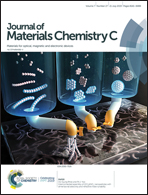High performance gold(iii)-based white organic light-emitting devices with extremely small efficiency roll-off
Abstract
High performance phosphorescent WOLEDs with small efficiency roll-offs (Δroll-off) at practical brightness levels have been constructed based on a traditional dichromatic structure consisting of yellow emission from alkynylgold(III) Au-Y and blue emission from FIrpic. The optimized WOLED with mCP and PYD2Cz as yellow and blue emissive hosts demonstrates a high current efficiency and EQE of 31.8 cd A−1 and 13.1%, respectively, and a stable cool white emission with CIE coordinates of (0.32 ± 0.02, 0.40 ± 0.01) over a wide luminance range. Unlike some other reported phosphorescent WOLEDs in the literature, our WOLED could operate high efficiencies of 30.4 cd A−1 and 12.9% even operating at a high practical brightness of 1000 cd m−2, giving a small Δroll-off of only 4%. This performance has been greatly improved over those of control devices with standard TCTA/mCBP hosts as well as with TCTA/[mCBP/PYD2Cz] having a composite blue host. The very short-lived emissive lifetime of only 0.4–0.7 μs for Au-Y is a key factor responsible for the small Δroll-off of the devices. Photoluminescence quantum yield (ΦPL) studies also reveal that the increase in ΦPL of Au-Y:mCP due to a more efficient host–emitter energy transfer could lead to a substantial enhancement of the overall performance of the WOLEDs.



 Please wait while we load your content...
Please wait while we load your content...